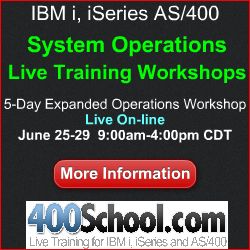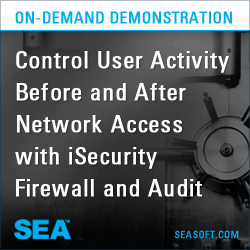
|
||
|
May 23, 2012 - Vol 2, Issue 9 |
||

|
||



|

Exit Points and Exit Programs
|
|
In This Issue
Feature Article Security Quick Links
Please Visit Our Sponsors
Platinum Sponsor |
IBM i Security and Audit ResourcesIBM i Security Videos from SecureMyi.com SecureMyi Newsletter Home and ArchivesIBM i Security Reference - IBM i 6.1 IBM i Security Reference - IBM i 7.1 QAUDJRN Audit Types By AUDLVL 6.1 QAUDJRN Entry Type Record Layout 6.1 RedBook - Security Guide for IBM i 6.1 PCI SSC Data Security Standards 


|


|
Carsten's Security Code for IBM i
Carsten's New CL Command to Manage the Intrusion Detection System for IBM iDownloadable Source code included!
By Carsten Flensburg In The January 4, 2012 issue of the SecureMyi Security Newsletter, Dan Riehl presented an Introduction to the Intrusion Detection System for IBM i. As I was doing additional research on the IDS(Intrusion Detection System) topic, I came across the "Control Intrusion Detection and Prevention API". This API(Application Programming Interface) is provided by IBM to allow you to perform some vital IDS management routines. I've wrapped the API up in a new CL command CTLIDS(Control Intrusion Detection System), giving me direct, green-screen access to the IDS functions supported by the API. Here is the command prompt display. - - - - - - - - - - - - - - - - - - - - - - - - - - - - - - - - - - - - - - - - - - - - - - - - - - - - - - - - - - - - - - - - - - - - - - - - - - - - - - - - -
Control IDS(CTLIDS)
Type choices, press Enter.
Option . . . . . . . . . . . . . *STATUS *ACTIVATE, *DEACTIVATE...
- - - - - - - - - - - - - - - - - - - - - - - - - - - - - - - - - - - - - - - - - - - - - - - - - - - - - - - - - - - - - - - - - - - - - - - - - - - - - - - - -
By pressing F1=Help during the prompt display, the Help Text explains the use of the command, the restrictions and additional information on the IDS. Listed here are selected snippets of the online Help Text. The Control Intrusion Detection and Prevention (CTLIDS) command is used to control the Intrusion Detection System (IDS). It can be used to activate, deactivate, recycle (deactivate and reactivate) the IDS or retrieve the status (active or inactive) of the IDS, and it is provided as an interface to the code that processes the IDS policy file. Note: TCP/IP Connectivity Utilities for i5/OS must be installed in order to use this command. Restrictions: You must have *IOSYSCFG special authority to run the command. The Option (OPTION) Parameter Specifies the requested function.
*ACTIVATE
Activate the Intrusion Detection System (IDS).
*DEACTIVATE
Deactivate the Intrusion Detection System (IDS).
*RECYCLE
Recycle the Intrusion Detection System (IDS).
*STATUS
Retrieve the status of the Intrusion Detection System (IDS).
The current status is returned in an informational message sent
to the job running the CTLIDS command.
In addition to controlling IDS, the CTLIDS command also verifies that TCP/IP is active and operational. The Source code that comprises the CTLIDS command is listed here. SEC101 RPGLE Control Intrusion Detection Services - CPP SEC101H PNLGRP Control Intrusion Detection Services - Help SEC101M CLP Control Intrusion Detection Services - Build cmd SEC101X CMD Control Intrusion Detection ServicesDownload a zip file containing all of the source code. Additional Resources:Control Intrusion Detection and Prevention (QTOQIDSC, QtoqIDSControl) API for IBM I 6.1 IBM Info Center - Complete coverage of IDS for IBM I 7.1 Introduction to the Intrusion Detection System for IBM i From the SecureMyi Security Newsletter Jan 4, 2012 |
||

|
||
IBM i Security News Bytes
Townsend Security Unveils Alliance LogAgent Suite
Raz-Lee Security Announces Change Tracker 1.0
New Book - Now Shipping - IBM i Security Administration and Compliance IBM i Security Calendar of Events
|



|
|
Security Shorts

Logon to the IBM i
|
Sponsored Links
IBM i, iSeries and AS/400
|
|

|
||

|
||
|
Send your IBM i Security Related News and Events! Sponsor the SecureMyi.com Security Newsletter © Copyright 2012 - SecureMyi.com, all rights reserved SecureMyi.com | St Louis MO 63017 |
||


